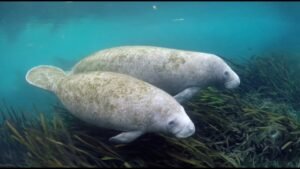A Wake-Up Call for Southshore

Here in Southshore, manatees aren’t just a beloved part of Florida wildlife—they’re a cornerstone of our identity. One of the biggest tourist draws in our area is the Manatee Viewing Center in Apollo Beach, where families, photographers, and visitors from across the state gather to watch these gentle giants bask in the warm waters near the power plant. It’s one of the few places where you can see manatees up close in their natural habitat, a rare and peaceful connection to the wild.
But that connection—and the manatees themselves—are under serious threat.
In a powerful report titled “Wasting Away,” the Tampa Bay Times detailed how hundreds of manatees have died in recent years due to starvation. Why? Because the underwater meadows of seagrass they depend on to survive are vanishing. In places like the Indian River Lagoon on Florida’s east coast, more than 90% of the seagrass is gone, replaced by barren sand and algae-choked water. The manatees that gather near power plants in the winter for warmth are now stuck there—with nowhere to go and nothing to eat.
What’s behind the die-off? Pollution. Runoff from farms, leaking septic tanks, lawn fertilizers, and stormwater carry nutrients like nitrogen and phosphorus into our waterways. Those nutrients fuel massive algae blooms that block sunlight and smother seagrass beds. Without sunlight, the seagrass dies. Without seagrass, the manatees starve.
Now, you might be thinking, “That’s the east coast—what’s it got to do with us over here in Southshore?” Unfortunately, quite a bit.
While the Indian River Lagoon has become the most visible example of ecological collapse, our waters on the Gulf Coast are far from immune. Tampa Bay has also seen a sharp decline in seagrass in recent years. Red tides and algae blooms, intensified by nutrient pollution, have left massive fish kills and murky water in their wake. And here in Southshore, we sit at the southern edge of the bay, downstream from everything that flows through the Alafia River and countless canals, ditches, and neighborhoods.
Our corner of the world is growing fast. With more homes, more pavement, and more people comes more runoff—unless we make serious changes. Every lawn treated with fertilizer, every septic tank that leaks, every storm drain that dumps into the bay contributes to the problem. And once that pollution is in the water, it doesn’t stay put. It spreads.
That means the health of our waters—the ones we boat, fish, kayak, and enjoy—is directly tied to the health of the broader estuary. And manatees? They’re just the canary in the coal mine. When they waste away, it’s a sign that the entire ecosystem is in trouble.
The good news? We can do something about it.
Reducing fertilizer use, upgrading old septic systems, preserving wetlands, supporting strong water quality regulations—these are all things that help. So does speaking up. Because if enough people demand better protection for our waterways, real change becomes possible.
Manatees may be the most visible victims of Florida’s water crisis, but they won’t be the last. What’s happening in the Indian River Lagoon is a warning. And we’d be wise to take it seriously—right here in Southshore.
